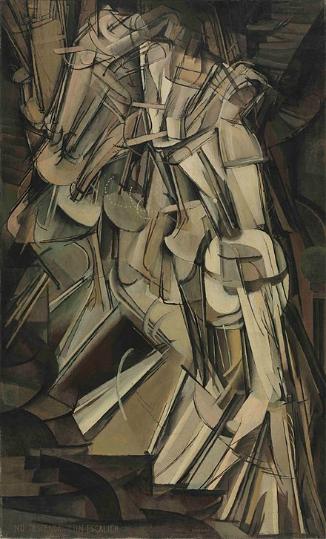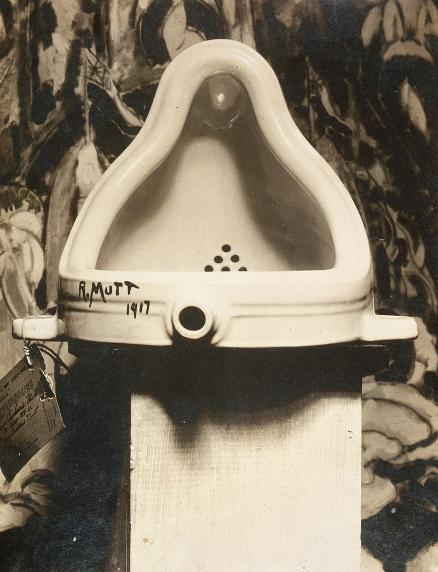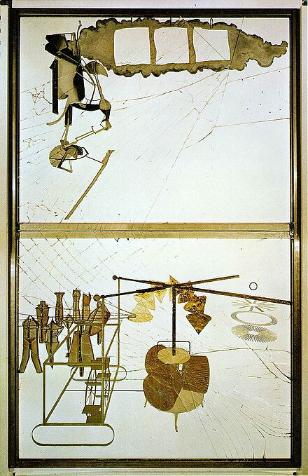Marcel Duchamp was a French-American artist whose work profoundly influenced the development of modern art. Known for his groundbreaking and often controversial works, Duchamp challenged conventional notions of what art could be, paving the way for movements such as DadaDada was an avant-garde art movement formed in the early 20th century in Zürich in reaction to the horrors of the First World War. The Dada artists believed that the war called into question any aspect of their society including the creation of art, therefore aiming at the demolition of traditional artistic values. On this basis, a new form of More and Conceptual ArtConceptual Art emerged in the 1960s as a movement that emphasized ideas and concepts over traditional aesthetic and material concerns. The movement challenges the traditional notion that the artwork must be a physical object, focusing instead on the intellectual engagement of the viewer. Sol Lewitt, Four-Sided Pyramid, 1999 Origins and Development Conceptual Art developed as artists began to question the More.

Early Life and Career
Marcel Duchamp was born on July 28, 1887, in Blainville-Crevon, France. He came from a family of artists and began his career as a painter, studying at the Académie Julian in Paris. Duchamp’s early works were influenced by Post-ImpressionismPost-Impressionism is an art movement that emerged in France in the late 19th century, following the close of the Impressionist era. While it retained the vivid color palette and real-life subject matter of Impressionism, Post-Impressionism rejected its limitations by emphasizing a more structured, formal composition and greater emotional depth. This movement was not defined by a single aesthetic but represented More and CubismSynthetic cubism was the later period of the Cubist art movement generally dated from 1912 – 1919. Artists of Synthetic Cubism moved away from the multi-perspective approach of Analytical Cubism in favour of flattened images that dispensed allusions of the three-dimensional space. Pablo Picasso, Clarinet, Bottle of Bass, Newspaper, Ace of Clubs (2013) The approach of the analytical phase was More, but he soon began to develop his unique approach to art, which questioned traditional aesthetics and the role of the artist.
Artistic Style
Duchamp’s style is characterized by:
- Readymades: Duchamp introduced the concept of the readymade, ordinary objects designated as art by the artist.
- Conceptual ArtConceptual Art emerged in the 1960s as a movement that emphasized ideas and concepts over traditional aesthetic and material concerns. The movement challenges the traditional notion that the artwork must be a physical object, focusing instead on the intellectual engagement of the viewer. Sol Lewitt, Four-Sided Pyramid, 1999 Origins and Development Conceptual Art developed as artists began to question the More: He emphasized ideas and concepts over traditional artistic techniques and aesthetics.
- Humor and Irony: Many of Duchamp’s works incorporate wit, humor, and irony, challenging the seriousness of the art establishment.
- Interdisciplinary Approach: Duchamp worked across various media, including paintingPainting is a fundamental form of visual art that has been practiced for thousands of years. It involves applying pigment to a surface such as canvas, paper, or a wall. Painting can be explored through various styles, techniques, and mediums, each offering unique possibilities for expression and creativity. Historical Background • Ancient Beginnings: The history of painting dates back to More, sculptureSculpture refers to a three-dimensional art form created by shaping or combining materials. Sculptors use various techniques to carve, model, cast, or construct their works, resulting in pieces that can be viewed from multiple angles. History and Origin Sculpture has a long history, dating back to prehistoric times. Early humans carved figures from stone, bone, and wood. These early sculptures More, and installation.

Major Works
- “Nude Descending a Staircase, No. 2” (1912): This paintingPainting is a fundamental form of visual art that has been practiced for thousands of years. It involves applying pigment to a surface such as canvas, paper, or a wall. Painting can be explored through various styles, techniques, and mediums, each offering unique possibilities for expression and creativity. Historical Background • Ancient Beginnings: The history of painting dates back to More caused a sensation at the 1913 Armory Show in New York for its dynamic depiction of movement, blending CubismSynthetic cubism was the later period of the Cubist art movement generally dated from 1912 – 1919. Artists of Synthetic Cubism moved away from the multi-perspective approach of Analytical Cubism in favour of flattened images that dispensed allusions of the three-dimensional space. Pablo Picasso, Clarinet, Bottle of Bass, Newspaper, Ace of Clubs (2013) The approach of the analytical phase was More and Futurism.
- “Fountain” (1917): Perhaps Duchamp’s most famous readymade, this work consists of a porcelain urinal signed “R. Mutt,” challenging the very definition of art.
- “L.H.O.O.Q.” (1919): A playful alteration of the Mona Lisa with a mustache and goatee, accompanied by a punning title, it mocks the reverence given to iconic works of art.
- “The Large Glass” (1915–1923): Also known as “The Bride Stripped Bare by Her Bachelors, Even,” this complex and enigmatic work combines paintingPainting is a fundamental form of visual art that has been practiced for thousands of years. It involves applying pigment to a surface such as canvas, paper, or a wall. Painting can be explored through various styles, techniques, and mediums, each offering unique possibilities for expression and creativity. Historical Background • Ancient Beginnings: The history of painting dates back to More, glass, and industrial materials to create a narrative of eroticism and mechanical forms.

Philosophical Influences
Duchamp’s work is deeply influenced by his engagement with philosophy, science, and the avant-garde.
- Anti-Art: Duchamp challenged the traditional boundaries of art, proposing that the artist’s intention could transform everyday objects into art.
- DadaDada was an avant-garde art movement formed in the early 20th century in Zürich in reaction to the horrors of the First World War. The Dada artists believed that the war called into question any aspect of their society including the creation of art, therefore aiming at the demolition of traditional artistic values. On this basis, a new form of More Movement: As a key figure in DadaDada was an avant-garde art movement formed in the early 20th century in Zürich in reaction to the horrors of the First World War. The Dada artists believed that the war called into question any aspect of their society including the creation of art, therefore aiming at the demolition of traditional artistic values. On this basis, a new form of More, Duchamp embraced absurdity, chance, and anti-bourgeois sentiments.
- Conceptual ArtConceptual Art emerged in the 1960s as a movement that emphasized ideas and concepts over traditional aesthetic and material concerns. The movement challenges the traditional notion that the artwork must be a physical object, focusing instead on the intellectual engagement of the viewer. Sol Lewitt, Four-Sided Pyramid, 1999 Origins and Development Conceptual Art developed as artists began to question the More: He laid the groundwork for Conceptual ArtConceptual Art emerged in the 1960s as a movement that emphasized ideas and concepts over traditional aesthetic and material concerns. The movement challenges the traditional notion that the artwork must be a physical object, focusing instead on the intellectual engagement of the viewer. Sol Lewitt, Four-Sided Pyramid, 1999 Origins and Development Conceptual Art developed as artists began to question the More by emphasizing ideas over the visual aesthetics of art.

Techniques and Materials
Duchamp employed various techniques and materials to achieve his distinctive style.
- Readymades: He selected everyday objects, recontextualizing them as art without altering their form.
- Assemblage: Combining different materials and objects, often in unexpected ways.
- Glass and Industrial Materials: Particularly in works like “The Large Glass,” he used unconventional materials to create complex, layered compositions.

Influence and Legacy
Marcel Duchamp’s impact on modern and contemporary art is profound, particularly in the fields of DadaDada was an avant-garde art movement formed in the early 20th century in Zürich in reaction to the horrors of the First World War. The Dada artists believed that the war called into question any aspect of their society including the creation of art, therefore aiming at the demolition of traditional artistic values. On this basis, a new form of More, Conceptual ArtConceptual Art emerged in the 1960s as a movement that emphasized ideas and concepts over traditional aesthetic and material concerns. The movement challenges the traditional notion that the artwork must be a physical object, focusing instead on the intellectual engagement of the viewer. Sol Lewitt, Four-Sided Pyramid, 1999 Origins and Development Conceptual Art developed as artists began to question the More, and the avant-garde.
- Readymades: Duchamp’s concept of the readymade revolutionized the art world, influencing countless artists and movements.
- Conceptual ArtConceptual Art emerged in the 1960s as a movement that emphasized ideas and concepts over traditional aesthetic and material concerns. The movement challenges the traditional notion that the artwork must be a physical object, focusing instead on the intellectual engagement of the viewer. Sol Lewitt, Four-Sided Pyramid, 1999 Origins and Development Conceptual Art developed as artists began to question the More: His emphasis on ideas and the dematerialization of art objects paved the way for Conceptual ArtConceptual Art emerged in the 1960s as a movement that emphasized ideas and concepts over traditional aesthetic and material concerns. The movement challenges the traditional notion that the artwork must be a physical object, focusing instead on the intellectual engagement of the viewer. Sol Lewitt, Four-Sided Pyramid, 1999 Origins and Development Conceptual Art developed as artists began to question the More.
- Pop ArtPop Art is a dynamic genre of modern art that emerged during the mid-20th century as a bold challenge to traditional art conventions. It focused on popular culture, using images from advertising, comic books, and the everyday to comment on the nature of mass production and consumerism. This entry delves into the key concepts, artists, and the broader impact of More and SurrealismSurrealism was a 20th-century philosophical, literary, and artistic movement seeking to channel the unconscious to access the imaginary. Proponents of Surrealism rejected the notion of understanding life in rational and conventional terms in favour of asserting the value of the unconscious mind, dreams, the strangely beautiful, and the uncanny. André Breton, the leader of a group of poets and artists More: Duchamp’s playful and ironic approach to art influenced later movements, including Pop ArtPop Art is a dynamic genre of modern art that emerged during the mid-20th century as a bold challenge to traditional art conventions. It focused on popular culture, using images from advertising, comic books, and the everyday to comment on the nature of mass production and consumerism. This entry delves into the key concepts, artists, and the broader impact of More and SurrealismSurrealism was a 20th-century philosophical, literary, and artistic movement seeking to channel the unconscious to access the imaginary. Proponents of Surrealism rejected the notion of understanding life in rational and conventional terms in favour of asserting the value of the unconscious mind, dreams, the strangely beautiful, and the uncanny. André Breton, the leader of a group of poets and artists More.
Major Exhibitions and Collections
Duchamp’s works have been featured in numerous major exhibitions and are held in prominent collections worldwide.
- The Museum of Modern Art (MoMA): New York’s MoMA features several of Duchamp’s works, highlighting his contributions to modern art.
- The Philadelphia Museum of Art: This museum houses the largest collection of Duchamp’s works, including “The Large Glass.”
- Tate Modern: London’s Tate Modern includes Duchamp’s works in its exhibitions, underscoring his international influence.
Conclusion
Marcel Duchamp remains a pivotal figure in the history of art, celebrated for his innovative and provocative approach. His contributions continue to influence and inspire artists and viewers, challenging conventional notions of what art can be.
Further Reading
For those interested in exploring Marcel Duchamp’s life and work further, consider these sources:
